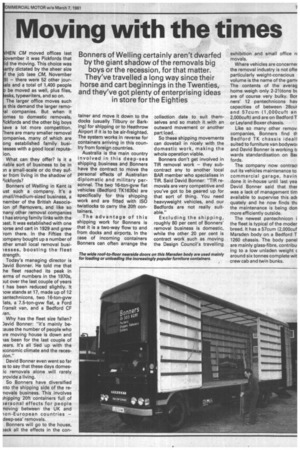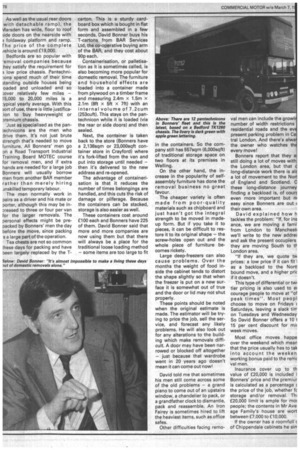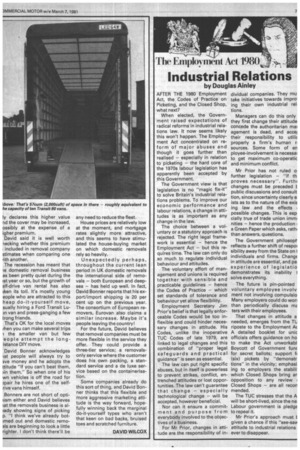Moving with the times
Page 77

Page 78

Page 79

If you've noticed an error in this article please click here to report it so we can fix it.
HEN CM moved offices last ovember it was Picicfords that id the moving. This choice was artly dictated by the sheer size f the job (see CM, November 9) — there were 52 other jourals and a total of 1,400 people be moved as well, plus files, esks, typewriters, and so on. The larger office moves such s this demand the larger remoal companies. But when it omes to domestic removals; ickfords and the other big boys ave a lot more competition. here are many smaller removal ornpanies, many of which are ong established family busiesses with a good local reputaion.
What can they offer? Is it a tiable sort of business to be in in a small-scale or do they sufer from living in the shadow of 'ickfords?
Bonners of Welling in Kent is ust such a company. It's a ;mall/medium-sized business, a n ember of the British Associaion of Removers, and like so n any other removal companies t has strong family links with the )ast. It was established with one iorse and cart in 1929 and grew
.rom there. In the Fifties the ;ompany bought up a number of
)ther small local removal busilesses, boosting the fleet itrength.
Today's managing director is /avid Bonner. He told me that he fleet reached its peak in erms of numbers in the 1970s, )ut over the last couple of years t has been reduced slightly. It low stands at 17, made up of 12 )antechnicons, two 16-ton-gvw lats, a 7.5-ton-gvw flat, a Ford fransit van, and a Bedford CF tan.
Why has the fleet size fallen? /avid Bonner: "it's mainly beause the number of people who ire moving house is down and las been for the last couple of tears. It's all tied up with the iconomic climate and the reces;ion."
David Bonner even went so far is to say that these days domesic removals alone will rarely )rovide a living.
So Banners have diversified nto the shipping side of the re
-nova's business. This involves
;hipping 20ft containers full of )ersonal effects for people
-'loving between the UK and ion-European countries — deep-sea' removals.
Bonners will go to the house, mck all the effects in the con
tamer and move it down to the docks (usually Tilbury or Barking) for shipping or to Heathrow Airport if it is to be air-freighted. The system works in reverse for containers arriving in this country from foreign countries.
Australia is the main country involved in this deep-sea shipping business and Bonners have the contract to move the personal effects of Australian diplomatic and military personnel. The two 16-ton-gvw flat vehicles (Bedford TK1630s) are specifically for this shipping work and are fitted with ISO twistlocks to carry the 20ft containers.
The advantage of this shipping work for Banners is that it is a two-way flow to and from docks and airports. In the case of incoming containers Banners can often arrange the collection date to suit themselves and so match it with an outward movement or another part load.
So these shipping movements can dovetail in nicely with the domestic work, making the whole operation viable.
Bonners don't get involved in TIR removal work — they subcontract any to another local BAR member who specialises in TIR. Said David Bonner: "TIR removals are very competitive and you've got to be geared up for that sort of thing. You need heavyweight vehicles, and our Bedfords are not really suitable."
Excluding the shipping, roughly 80 per cent of Bonners' removal business is domestic, while the other 20 per cent is contract work such as moving the Design Council's travelling exhibition and small office rt movals, Where vehicles are concernet the removal industry is not ofte particularly weight-conscious • volume is the name of the gam( The contents of the averag
home weigh only 2-21/2tons bt are of course very bulky. Bor. ners' 12 pantechnicons hay capacities of between 28cur and 57cum (1,0 0 Ocuft an 2,000cuft) and are on Bedford T or Leyland Boxer chassis.
Like so many other remov, companies, Bonners find th Bedford TK chassis ideall suited to furniture van bodywol and David Bonner is working tc wards standardisation on Bec fords.
The company now contrad out its vehicles maintenance to commercial garage, havin done it in-house until last yea David Banner said that ther was a lack of management tim available to supervise this ad( quately and he now finds thi the maintenance is being don more efficiently outside.
The newest pantechnicon i the fleet is typical of the moder breed. It has a 57cum (2,000cuf Marsden body on a Bedford T 1260 chassis. The body panel are mainly glass-fibre, contribu ing to a low unladen weight c around six tonnes complete wit crew cab and twin bunks.
As well as the usual rear doors with detachable ramp), the Vlarsden has wide, floor to roof ;ide doors on the nearside with 3 foldaway platform and ramp. rhe price of the complete /ehicle is around £19,000.
Bedfords are so popular with -emoval companies because .hey satisfy the requirement for s low price chassis. Pantechnimns spend much of their time standing outside houses being oaded and unloaded and so -...over relatively few miles 15,000 to 20,000 miles is a :ypical yearly average. With this sort of use, there is little justifica.ion to buy heavyweight or oremium chassis.
Just as specialised as the pantechnicons are the men who irive them. It's not just brute strength that's needed to move furniture. All Bonners' men go on a Road Transport Industrial Training Board MOTEC course for removal men, and if extra hands are needed for a large job Bonners will usually borrow men from another BAR member rather than merely hiring inskilled temporary labour.
The men normally work in pairs as a driver and his mate or porter, although this may be in-,1-eased to three or four per van for the larger removals. The personal effects might be prepacked by Bonners' men the day before the move, since packing s a large part of the operation.
Tea chests are not so common :hese days for packing and have peen largely replaced by the T
carton. This is a sturdy cardboard box which is bought in flat form and assembled in a few seconds. David Bonner buys his T-cartons from BAR Services Ltd, the co-operative buying arm of the BAR, and they cost about 90p each.
Containerisation, or palletisetion as it is sometimes called, is also becoming more popular for domestic removal. The furniture and household effects are loaded into a container made from plywood on a timber frame and measuring 2.4m x 1.5m x 2.1m (8ft x 5ft x 7ft) with an internal volume of 7.2cum (253cuft). This stays on the pantechnicon while it is loaded (via the rear or side doors) and then sealed.
Next, the container is taken back to the store (Banners have a 2,138sqm or 23,000sqft container store in Crayford) where it's fork-lifted from the van and put into storage until needed — then it's delivered to the new address and re-opened.
The advantage of containerisation is that it reduces the number of times belongings are handled, and this cuts the risk of damage or pilferage. Because the containers can be stacked, storage is also easier as well.
These containers cost around £100 each and Bonners have 225 of them. David Bonner said that more and more companies are now using them but that there will always be a place for the traditional loose loading method — some items are too large to fit in the containers. So the company still has 557sqm (6,000sqft) of traditional storage space on two floors at its premises in Welling.
On the other hand, the increase in the popularity of selfassembly furniture has done the removal business no great favour.
The cheaper variety is often made from poor-quality materials such as chipboard and just hasn't got the integral strength to be moved in madeup form. But if you take it to pieces, it can be difficult to restore it to its original shape — the screw-holes open out and the whole piece of furniture becomes rickety.
Large deep-freezers can also cause problems. Over the months the weight of food inside the cabinet tends to distort the shape slightly so that when the freezer is put on a new surface it is somewhat out of true and the door or lid may not shut properly.
These points should be noted when the original estimate is made. The estimator will be trying to price the job, sell the service, and forecast any likely problems. He will also look out for any alterations to the building which make removals difficult. A door may have been narrowed or blocked off altogether — just because that wardrobe went in 20 years ago doesn't mean it can come out now!
David told me that sometimes his men still come across some of the old problems — a grand piano to come out of an upstairs window, a chandelier to pack, or a grandfather clock to dismantle, pack and reassemble. An Iron Fairey is sometimes hired to lift the heaviest items, such as office safes.
Other difficulties facing remo val men can include the growi number of width restrictions residential roads and the ev present parking problem in Ce tral London. And there's alwa the owner who watches th every move!
Banners report that they a still doing a lot of moves with the London area, but that long-distance work there is al, a lot of movement to the Non1 of England and Scotland. 0 these long-distance journey finding a backload is, of cour; even more important but ni easy since Bonners are out their own area.
David explained how h tackles the problem: "If, for ins ance, we are moving a fami from London to Manchesti we'll write to the new addre: and ask the present occupiers they are moving South to London area.
"If they are, we quote tvu prices: a low price if it can fit as a backload to the Nortl bound move, and a higher pric if it doesn't.
This type of differential or twi tier pricing is also used to ei courage people to move at "of peak times". Most peopl choose to move on Fridays c Saturdays, leaving a slack tirr on Tuesdays and Wednesday So David Banner offers a 10 1 15 per cent discount for mic week moves.
Most office moves happe over the weekend which mean that the price usually has to tak into account the weaken working bonus paid to the rem( val men.
Insurance cover up to th value of £20,000 is included i Bonners' price and the premiur is calculated as a percentage c the price of the job, whether fc storage and/or removal. Th £20,000 limit is ample for mo: people; the contents in Mr Ave age Family's house are wort between £7,000 to £1 0,000.
If the owner has a roomfull of Chippendale cabinets he sin. ly declares this higher value ad the cover may be increased, ossibly at the expense of a igher premium.
David said it is well worth lecking whether this premium included in removal company stimates when comparing one rith another.
The recession has meant that le domestic removal business as been pretty quiet during the ist year or so, but the growth of elf-drive van rental has also iken its toll. It's mostly young eople who are attracted to this heap do-it-yourself move, sually hiring a Ford Transit Lu)n van and press-ganging a few trong friends, That's OK for the local moves then you can make several trips 1 the smaller van but few eople attempt the longistance DIY move.
David Bonner acknowledges let people will always try to eve money and he adopts the ttitude "If you can't beat them, ain them." So when one of his wn vehicles is off the road for ?pair he hires one of the selfrive vans himself.
Bonners are not short of optiiism either and David believes at the removals business is al?ady showing signs of picking p. "I think we've already botrmed out and domestic remoels are beginning to look a little righter. I don't think there'll be any need to reduce the fleet.
House prices are relatively low at the moment, and mortgage rates slightly more attractive, and this seems to have stimulated the house-buying market on which domestic removals rely so heavily.
Unexpectedly perhaps, throughout the current lean period in UK domestic removals the international side of removals — both European and deepsea — has held up well. In fact, David Bonner reports that his export/import shipping is 20 per cent up on the previous year. The consortium of European removers, Eurovan also claims a similar increase. Maybe it's people leaving the country!
For the future, David believes that removal companies must be more flexible in the service they offer. They could provide a three-tier service; a removalsonly service where the customer does his own packing, a standard service and a de luxe servicebased on the containerisation.
Some companies already do this sort of thing, and David Banner thinks that this flexible and more aggressive marketing attitude is the way forward, hopefully winning back the marginal do-it-yourself types who aren't that keen on bad backs, bruised toes and scratched furniture.
DAVID WILCOX
























































































































